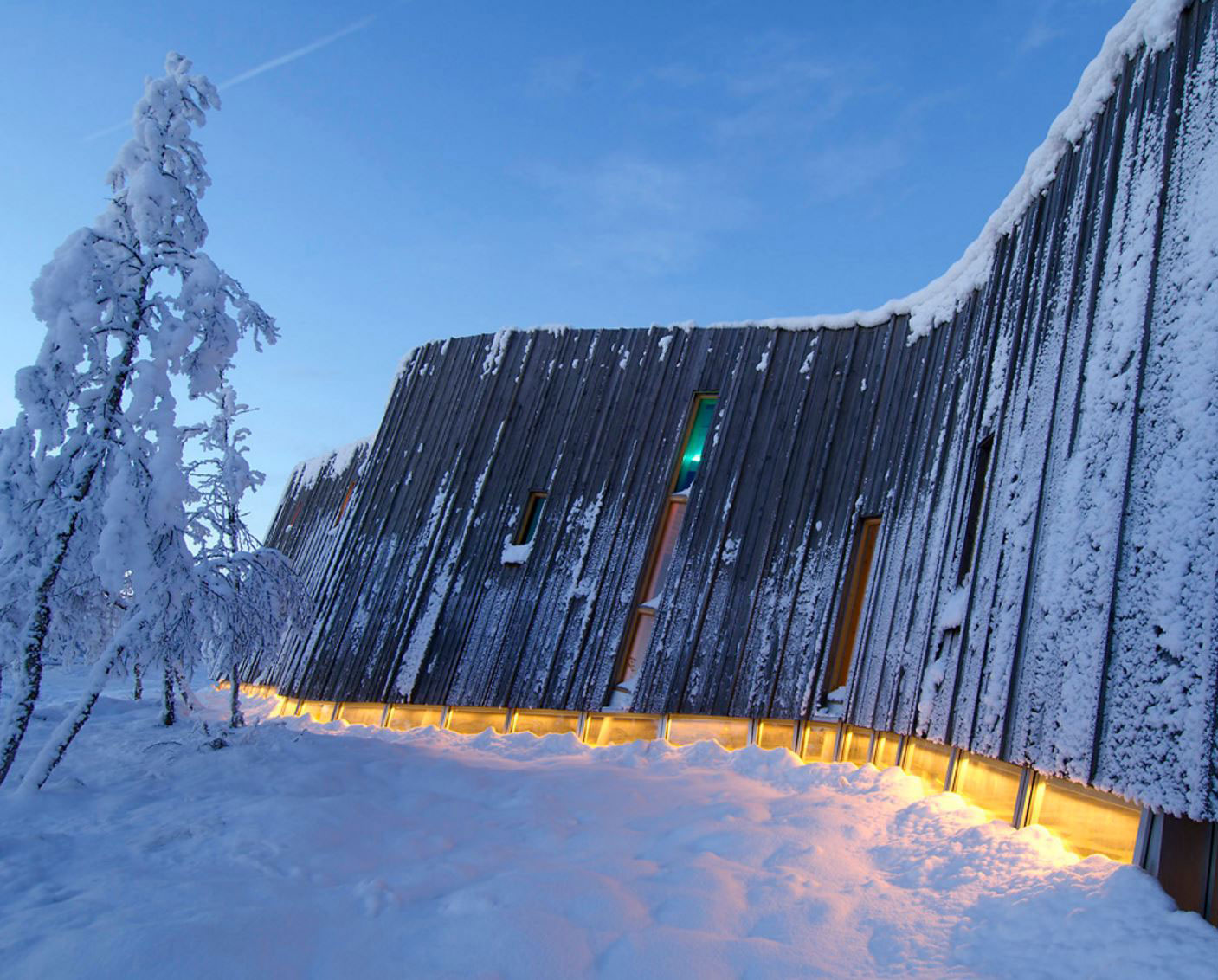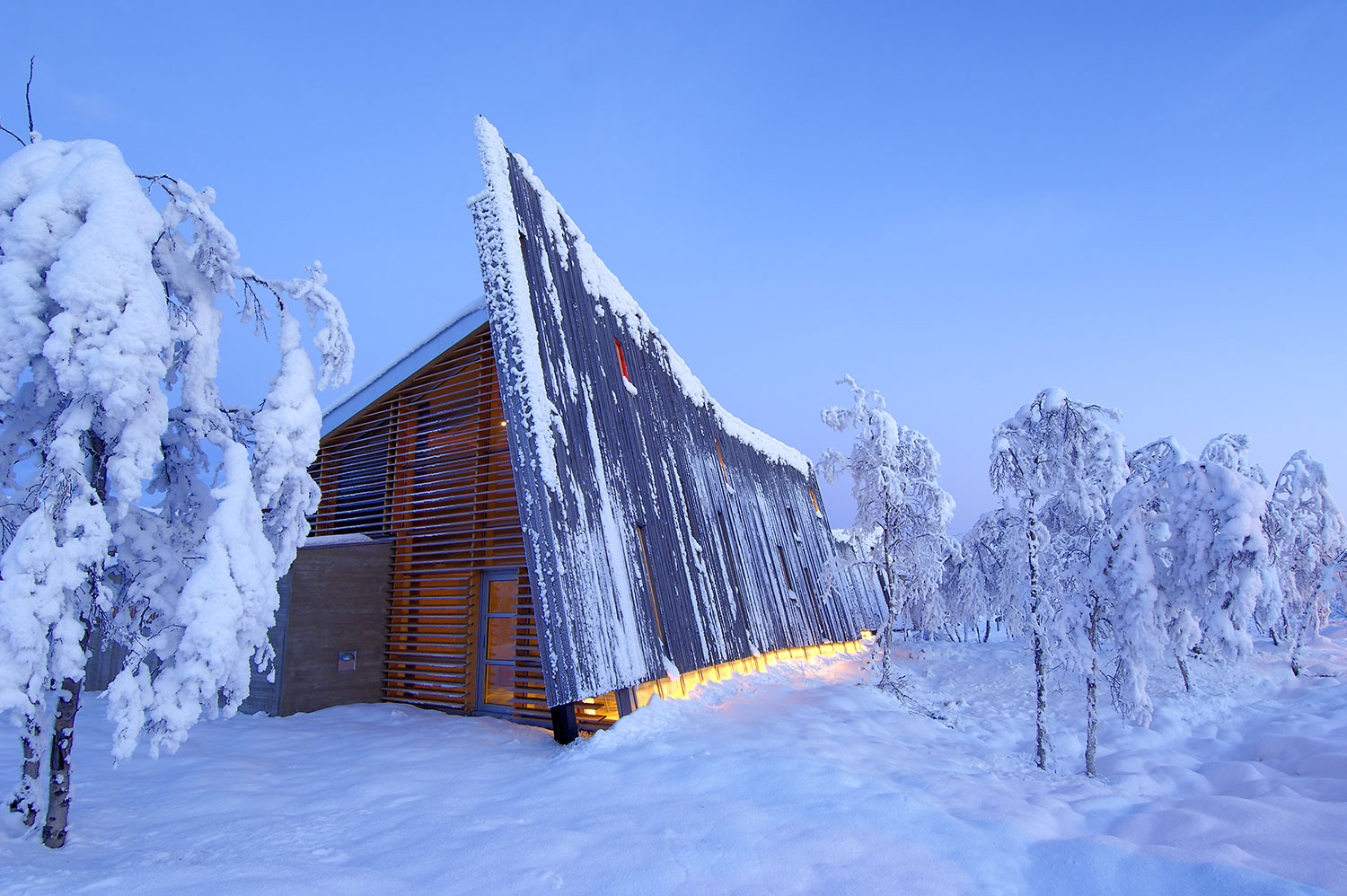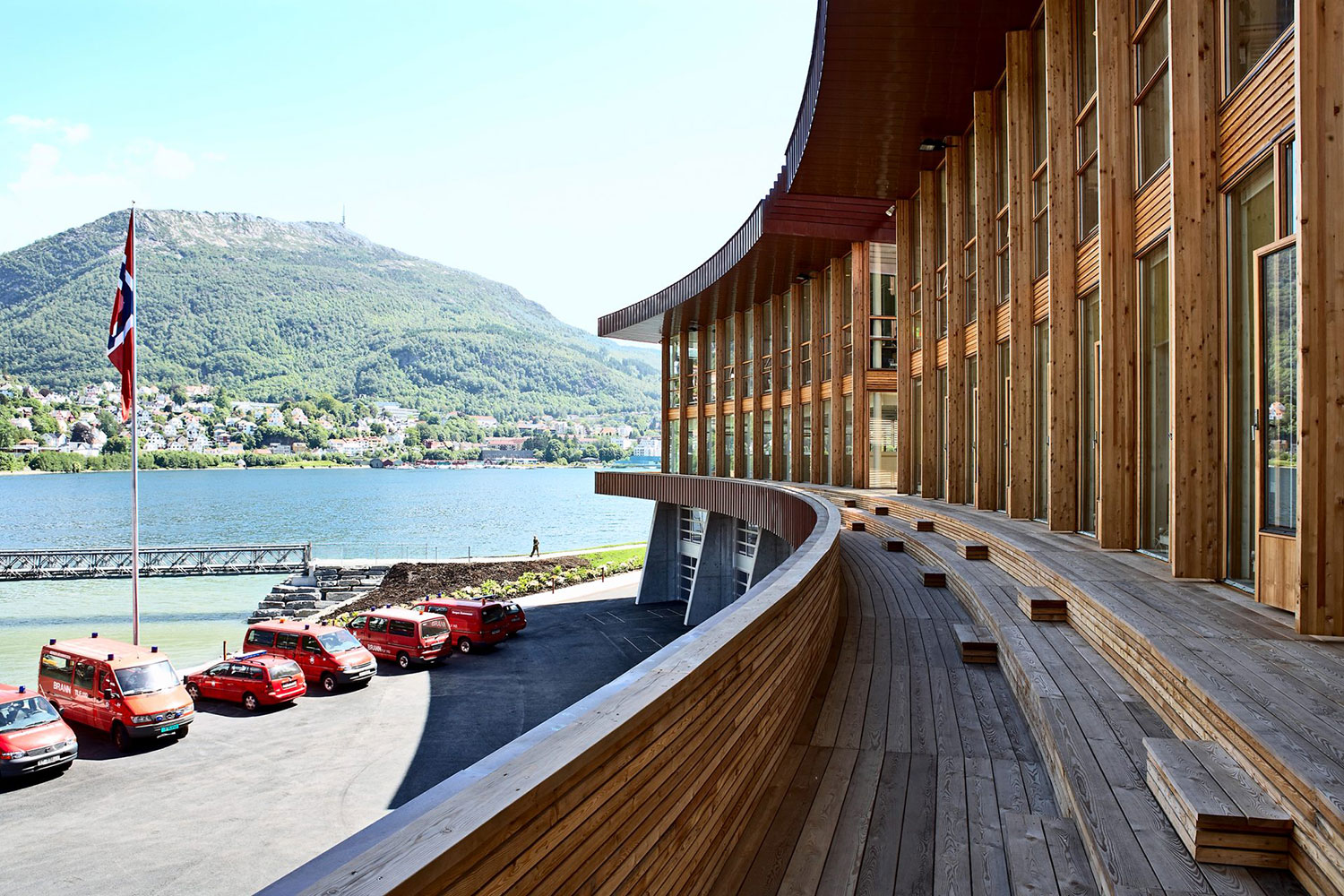Last summer BUILD met with Norwegian architect Stein Halvorsen at his office in Oslo, Norway where we discussed the magic of design, working in Norway’s northern regions, and reparations via architecture.

[Tana Courthouse, photo by Bjarne Riesto]
Your website notes your firm’s commitment to balancing man and nature in your work. Does this approach differentiate your projects from other firms’ in this regard?
A lot of Norwegian architects are interested in the natural environment. I have been close to nature since I was a small boy when I would go fishing with my father, and we spent a lot of time outdoors; I did the same as a young man, and with my sons. In my office, we always try to establish connections between interior and exterior spaces, and because we don’t have a lot of sun, it’s easy to include large windows. I think, too, that due to our climate, Norwegian people are more connected to nature than people in other European cities.
Our Sámi Parliament project in Karasjok allowed me to get to know and work closely with the Sámi people, who have a deep connection with nature. Considering the global dialogue about climate change, we should really follow the lead of the Sámi people who live at one with nature. You don’t really see their houses and tents, called lavvu, in the landscape because their dwellings are so integrated with the earth. And then when they move on — some of them are semi-nomadic reindeer herders — they don’t leave a trace. While we’re alive, people borrow the clothing of the earth, and then when we go away, we should not leave a footprint.
Much of your built work started as architectural competitions—how have you been successful at wining these?
I think it’s because I’m not that concerned with the details— when working with concepts – I try to follow my intuition. I appreciate details, but when I first approach a new project, I try to think in broad strokes. I believe that the details don’t matter if you don’t have a good context. Big picture thinking is what makes a competition architect, and this is what sets my firm apart. The details come later.
How is it possible to keep an architecture firm financially sound with a dependence on competitions? Are you paid to do competitions?
For a time, I worked for several large firms in Norway and Italy, so I could devote my spare time to competitions. When I prepared my entry for the Sámi parliament competition, I was employed at a large firm in Norway, Niels Torp Architects, so I didn’t have to worry about spending time on it. I was lucky to have won. I always wanted to start my own office, and I was waiting for the right project to help me to do this, which the parliament project did. In the early days of our office we would work on competitions after hours; some were paid, but the fee on those was typically very small, and we probably used four to five times more resources than the amount of the stipend. In our first ten years we did a lot of open competitions, which were not paid, but some years we won 75% of them.
Tell me a bit about the Sámi— who they are, their culture, and their relation to Norway.
The Sámi people are profoundly connected to nature and to their animals, their reindeer. They speak very softly, and they don’t live by a clock; when they are out in the fields, they don’t think about the time of day. I went fishing once with a Sámi man, in the middle of nowhere, and we traveled up a narrow river in a boat that was long and thin and had a motor; the way he was able to maneuver through the currents and stones was so fascinating. He said that he is probably one of the last Sámi to be able to navigate the river because the next generation goes to school in the city and they’re not learning this and other cultural skills. The Sámi people really have a deep understanding of nature, which we all should.
How do the Sámi Parliament and Tana Courthouse that your firm designed set a precedent for Sámi culture?
The Sámi Parliament project was very difficult because the Sámi have never created such large buildings. They only had a parliamentary government for a few years before doing this project. It’s interesting that people can live without politicians. They have them now, but I’m not sure how it’s functioning.

[Sami Parliament, photo by Bjarne Riesto]
How did the Sámi afford their parliament building?
The Norwegian government had treated the Sámi very poorly for hundreds of years, and then they concluded that they must make reparations, so they gave the Sámi a significant financial gift. As we began construction they received even more when the Prime Minister visited the project site and we told him that the building would benefit from a better floor material; the day after he arrived back home, he sent a check for $10mm Krones to the Sámi to pay for the enhanced floor. We are lucky to have worked with the Sámi people because they have a different approach to life than we have.
Given the deliberate isolation of the Sámi people, what was your experience as an outsider designing for/with them? Why bring an outside architect in?
They didn’t have any architects in their community, and the parliament was a big, complex building. I was lucky to get the opportunity to be a part of this. They were so friendly, much more so than Norwegian people, and they really embraced me. I think nature prepares the Sámi people to behave this way. Everyone acts differently when they are in the mountains.
You’re very good at enrolling traditional communities in modern design—how do you do this?
We should never do romantic buildings, because we are living in a modern time. I experienced this with the Sámi people—they are living in the here and now, they are not romantic. Everything they do is driven by function. Design is rarely a result of function. The temperature in the mountains can reach -50 Celsius (-58 Fahrenheit), so they always have an open fire in their lavvus; it’s very important how they stack the logs outside and inside the lavvu, and how they place them on the fire itself. It can be dangerous to spend too much time outside in that temperature—if you must look around for wood in the middle of the night, you could die. This is knowledge that is handed down. Everything for them is about survival in a hard climate.
What is being lost with traditional Norwegian architecture that you’d like to keep?
At school I was very lucky to have had four semesters with Sverre Fehn. I also live in the first house he designed, so I have a deep Norwegian architecture experience every day. What he learned is that architecture is much more than just designing and building a house; it’s about poiesis, and how the architecture tells a story. Fehn was a master at this. You feel the magic in his projects.

[Hvaler Cabin, photo by Espen Grønli]
How do you enroll a client in the poiesis?
Sverre Fehn said no to a lot of projects because the client didn’t want this.
Do you know when to walk away from a project?
I sometimes find out too late that the client wasn’t the right one, unfortunately.
Are there technical or cultural design aspects that you’ve found to fail in Norway?
I have an education in engineering, too, so I should be occupied with technique, but it’s much more important to talk about the culture behind the architecture, and how to make projects in a harsh climate. This is good experience for our entire office. The conditions in the north are much worse than in Oslo, so we must ensure that the architecture responds to the climate. Oslo is like France or Germany, so our responses to architecture here don’t translate. It’s warm here, and there’s a lot of light. It’s different in the north; when we work up in the North, we learn a lot because of the harsh weather conditions. We can use these lessons in Oslo, even though the conditions are different.
Your work always has a thoughtful contrast—is it deliberate?
Yes, for sure. Also, the graphic quality of our buildings, on the facades and in the interiors, creates contrast. When I spent time with the Sámi on their land, when the darkness would come, everything changed. The way the buildings looked changed. As architects we have to draw the night façade, to turn it upside down. It’s a kind of graphic. Our colleagues can identify our work because there are expressions that are consistent.

[Sami Parliament, photo by SH Arkitekter]
What are your current challenges in architecture?
These days we’re doing a lot of fire stations, about ten in Norway. We do every kind of project, which I think is necessary. I also enjoy working on small cottages—it’s nice to get close to a client’s humanity, and we have to think hard about the details and textures. By doing the small projects, we learn a lot about the big projects. It’s like going to school again. Competitions are also great for our continuing education.
What are Norway’s building codes and building departments like to work with?
It depends on which part of Norway we’re working in, and which community. Finnmark, in the north, is much easier. When projects are closer to the big city center, they become more difficult. All the communities must approve the work. What has changed over the last years is that there are hardly any architects working in the communities any longer. This is such a pity.
How has your own work evolved and matured over your career? What would you say took the most time to cultivate?
I’m heavily involved in almost all our projects, and every building is very hard for me. It can be very difficult to find solutions; all aspects are equally challenging. I don’t get my ideas very quickly, and it takes time to refine them. I only work with pen and paper—I sketch a lot. The hand sketching improves my ideas, it’s more visual to me. At last the drawing takes on a life of its own in a way.
What are you most proud of over the course of your career?
When my colleagues and I look at what we’ve done, there aren’t that many projects we’re proud of, maybe 10% and, that makes about 10 projects. I want to mention The Sámi Parliament, Viken Skog, Sal Haaken and Tana courthouse. We succeeded with those ones.

[Tana Courthouse, photo by Bjarne Riesto]
What would you like people to understand about your work that isn’t necessarily apparent?
My aim is for people to feel magic in my work. Sometimes when I visit a new project, I can feel when an architecture has achieved poiesis. Zumthor’s Therme Vals baths in Switzerland has this quality. You must experience it, in summer and winter. A photo does not convey the experience; you must swim and spend several hours there, smell the air, experience the light and darkness, the warm and cold water. It’s out of this world.
What would you like the rest of the Design world to better understand about Norway?
I want them to know that we are modern and that we have modern architecture. I went to America for a competition for a parliament in Alaska. It was a strange and good experience. Morphosis won the competition, but the project is still unbuilt. It was a very nice and different experience.
Is there one book you think all architects should read?
I would suggest one of the booklets of Sverre Fehn—his writings, not a book of photographs, and two other books by different authors. When he was my teacher, he never told me how to do anything. He would say, If you’re entering this type of building, what would you do? Calm down and think about how you would like to enter this building?
The Poetry of the Straight Line by Sverre Fehn, 1992
The Skin, the Cut & the Bandage (The Pietro Belluschi Lectures) by Sverre Fehn, 1997
Das Geheimnis des Schattens by Debbie Ford, 2002
Are there other aspects of your practice or projects that you want to tell me about?
My main concern is to begin every project with nature – to take metaphors from these spaces.
I have to think about how the client and the architecture will engage with the natural environment. When designing the house I live in, Sverre Fehn thought about the spaces metaphorically: the living room is part of a cave, close to an open fire. When working outside I have to make decisions about where to sit, how to sit, what to see. I think about these things. Architecture is very much about what you don’t see with your eyes.
Stein Halvorsen attended Oslo University College of Engineering and Oslo School of Architecture. He worked for several large firms, including Niels Torp Architects before he founded Stein Halvorsen Arkitekter AS in 1996. Since then, the firm has grown to 30 team members and includes offices in Oslo and Tønsberg. Halvorsen has been one of the pioneers in ecological thinking in construction projects.







